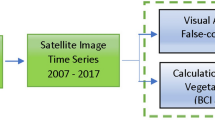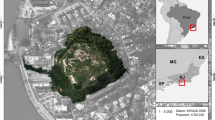Abstract
In Brazil, as in the world, the mining sector is expanding steadily. Currently, the sector accounts for 11.5% of Brazil’s GDP, and the country is the world’s fifth-largest producer of mining products. The environmental impacts of mining and other activities that compete for land use need to be evaluated. The objective of this work was to assess vegetation recomposition in an area where bauxite extraction occurred, using analysis of a vegetation index calculated from satellite images. The method was applied at a bauxite mine in Paragominas, Pará, Brazil. The evaluations covered the steps of opening the area, mining operations, and replanting, considering three types of replanting: natural regeneration, traditional planting, and nucleation, for the period between 2013 and 2019, using 2006 as the base situation for the secondary forest. The results showed that the replanting method directly influences the vegetation index according to satellite images. Several factors affected the values obtained, such as operational factors and topsoil used. The natural regeneration method was found to produce the best results.
Graphic abstract








Similar content being viewed by others
References
Asrar G, Fuchs M, Kanemasu ET, Hatfield JL (1984) Estimating absorbed photosynthetic radiation and leaf area index from spectral reflectance in wheat. Agron J 76(2):300–306. https://doi.org/10.1016/0034-4257(85)90108-7
Assmann E (1970) The principles of forest yield study—studies in the organic production, structure, increment and yield of forest stands. Pergamon Press, Oxford
Baghdadi N, Zribi M (2016) Optical remote sensing of land surface, 1st edn. ISTE Press, London
Brazilian Economy Ministry (2020) Foreign trade statistics—history series. www.mdic.gov.br/index.php/comercio-exterior/estatisticas-de-comercio-exterior/series-historicas. Accessed 05 April 2020
Brown CL (1974) Secondary growth. In: Zimmermann MH, Brown CL (eds) Trees structure and function. Springer, New York
Chaves MED, Lázaro AS, Nassur OAC, Conceição FG (2013) Utilization of EVI and NDVI vegetation indices as a tool for analysis of vegetation dynamics in Serra da Canastra National Park—MG. In: XVI Brazilian symposium on remote sensing (in Portuguese)
Cicore P, Serrano J, Shahidian S, Sousa A, Costa JL, da Silva JRM (2016) Assessment of the spatial variability in tall wheatgrass forage using LANDSAT 8 satellite imagery to delineate potential management zones. Environ Monit Assess 188(9):513. https://doi.org/10.1007/s10661-016-5512-z
Côrrea RS (2009) Recovery of areas degraded by mining in the cerrado. Universa, Brasília (in Portuguese)
de Carvalho SP, da Costa MC, de Oliveira MDCF (2005) Rainfall behavior in the municipality of Paragominas-PA. XIV Brazilian Congress of Agrometeorology, Campinas, São Paulo, Brazil, 2 (in Portuguese)
de Miranda E, de Carvalho CA, Martinho PRR, Oshiro OT (2020) Contributions of geoprocessing to the understanding of the rural world and deforestation in the Amazon biome. COLOCHIO Rev Reg Dev 17(1):16–34
DNPM (2017) Departamento Nacional de Produção Mineral—Brazilian Department of Mineral Production. State Mineral Directory. www.dnpm-pe.com. Accessed 25 Feb 2019
DNPM (2018) Departamento Nacional de Produção Mineral—Brazilian Department of Mineral Production. Brazilian Mineral Yearbook: Main Metallic Substances. www.dnpm-pe.com. Accessed 1 Mar 2019
Ducart DF, Silva AM, Toledo CLB, Assis LM (2016) Mapping iron oxides with Landsat-8/OLI and EO-1/Hyperion imagery from the Serra Norte iron deposits in the Carajás Mineral Province, Brazil. Braz J Geol 46(3):331–349 (in Portuguese)
Epiphanio JC, Gleriani JM, Formaggio AR, Rudorff BF (1996) Vegetation indices in the remote sensing of bean culture. Braz Agric Res 31(6):445–454 (in Portuguese)
Faria TDO, Rodrigues TR, Curado LFA, Gaio DC, Nogueira JDS (2018) Surface albedo in different land-use and cover types in the Amazon forest region. Ambiente e Agua Interdiscip J Appl Sci 13(2):1. https://doi.org/10.4136/ambi-agua.2120
Francez LMDB, Carvalho JOPD, Jardim FCDS, Quanz B, Pinheiro KAO (2009) Effect of two wood harvesting intensities on the structure of a natural forest in the region of Paragominas, Pará. Acta Amaz 39(4):851–863 (in Portuguese)
Gao X, Huete AR, Ni W, Miura T (2000) Optical-biophysical relationships of vegetation spectra without background contamination. Remote Sens Environ 74:609–620. https://doi.org/10.1016/S0034-4257(00)00150-4
Gessner U, Naeimi V, Klein I, Kuenzer C, Klein D, Dech S (2013) The relationship between precipitation anomalies and satellite-derived vegetation activity in Central Asia. Glob Planet Change 110:74–87. https://doi.org/10.1016/j.gloplacha.2012.09.007
Guimarães JCC (2008) Rehabilitation of bauxite mines in native forests: “traditional method” versus “ecological method”. Agric Livest Rep 29(244):30–33 (in Portuguese)
Horning N (2008) Remote sensing. Encycl Ecol 4:2986–2994
Huete A, Justice C, Van Leeuwen W (1999) MODIS vegetation index (MOD13). Algorithm theoretical basis document, vol 3, p 213
Huete A, Didan K, Miura T, Rodriguez EP, Gao X, Ferreira LG (2002) Overview of the radiometric and biophysical performance of the MODIS vegetation indices. Remote Sens Environ 83:195–213. https://doi.org/10.1016/S0034-4257(02)00096-2
IBGE (2019) Instituto Brasileiro de Geografia e Estatística—Brazilian Institute of Geography and Statistics. Panorama of Paragominas-PA. https://cidades.ibge.gov.br/brasil/pa/paragominas/panorama. Accessed 22 Dec 2019
INPE (2019) Instituto Nacional De Pesquisas Espaciais—National Institute of Space Research. Project PRODES: Satellite Monitoring of Deforestation of the Brazilian Amazon Forest. http://www.obt.inpe.br/OBT/assuntos/programas/amazonia/prodes. Accessed 29 July 2020 (in Portuguese)
Johansen K, Coops NC, Gergel SE, Stange Y (2007) Application of high spatial resolution satellite imagery for riparian and forest ecosystem classification. Remote Sens Environ 110(1):29–44. https://doi.org/10.1016/j.rse.2007.02.014
Junges AH, Alves G, Fontana DC (2007) Indicative study of the behavior of NDVI and EVI in winter cereal crops of the northern region of the State of Rio Grande do Sul, through MODIS images. In: Anais XIII Brazilian symposium on remote sensing, pp 241–248 (in Portuguese)
Khan SAR, Sharif A, Golpîra H, Kumar A (2019) A green ideology in Asian emerging economies: from environmental policy and sustainable development. Sustain Dev 27(6):1063–1075. https://doi.org/10.1002/sd.1958
Khan SAR, Zhang Y, Kumar A, Zavadskas E, Streimikiene D (2020) Measuring the impact of renewable energy, public health expenditure, logistics, and environmental performance on sustainable economic growth. Sustain Dev 1:1. https://doi.org/10.1002/sd.2034
Kobiyama M, Minella JPG, Fabris R (2001) Degraded areas and their recovery. Agric Livest Rep Belo Horizonte 22(210):10–17 (in Portuguese)
Kuan SH, Ghorbani Y, Chieng S (2020) Narrowing the gap between local standards and global best practices in bauxite mining: a case study in Malaysia. Resour Policy 66:101636. https://doi.org/10.1016/j.resourpol.2020.101636
Kuplich TM, Moreira A, Fontana DC (2013) Time series of vegetation index on different plant typologies in Rio Grande do Sul. Braz J Agric Environ Eng Camp Gran 17(10):1116–1123. https://doi.org/10.1590/S1415-43662013001000014(in Portuguese)
Laurentino MLS, da Silva HA, da Silva JCB, Santana SHC, Morais YCB, Galvíncio JD (2011) Application of the NDVI and EVI indices as an analysis of the physiognomic variation of the vegetation in the Brejo de Altitude of Serra Negra-Bezerros/PE-Brasil. In: XV Brazilian symposium on remote sensing (in Portuguese)
Martins WBR, Lima MDR, Junior UDOB, Amorim LSVB, de Assis Oliveira F, Schwartz G (2020) Ecological methods and indicators for recovering and monitoring ecosystems after mining: a global literature review. Ecol Eng 145:105707. https://doi.org/10.1016/j.ecoleng.2019.105707
Matsushita B, Yang W, Chen J, Onda Y, Qiu G (2007) Sensitivity of the Enhanced Vegetation Index (EVI) and Normalized Difference Vegetation Index (NDVI) to topographic effects: a case study in high-density cypress forest. Sensors 7:2636–2651. https://doi.org/10.3390/s7112636
Melo ET, Sales MCL, Oliveira JGB (2011) Application of the Normalized Difference Vegetation Index (NDVI) for the analysis of the environmental degradation of the crater micro basin of the Cavacho Creek, Crateús-CE. Geogr Space Anal 23:520–533 (in Portuguese)
Ostojić G, Lazić D, Škundrić B, Škundrić JP, Sladojević S, Kešelj D, Blagojević D (2014) Chemical-mineralogical characterization of bauxites from different deposits. Contemp Mater 1:84–94. https://doi.org/10.7251/COMEN1401084O
Parrotta JA, Knowles OH (2001) Restoring tropical forests on lands mined for bauxite: examples from the Brazilian Amazon. Ecol Eng 17(2–3):219–239. https://doi.org/10.1016/S0925-8574(00)00141-5
Pinheiro J, Cunha S, Gomes G, Carvajal S (2012) Probability and statistics: quantifying uncertainty. GEN LTC, 1st edn. Elsevier, Brasil (in Portuguese)
Reis A, Bechara FC, Espindola MB, Vieira NK, Souza LL (2003) Restoration of damaged land areas: using nucleation to improve successional processes. Nat Conserv 1(1):85–92
Reis A, Bechara FC, Tres DR (2010) Nucleation in tropical ecological restoration. Sci Agric 67(2):244–250. https://doi.org/10.1590/S0103-90162010000200018
Rochon GL, Johannsen CJ, Landgrebe DA, Engel BA, Harbor JM, Majumder S, Biehl LL (2003) Remote sensing as a tool for achieving and monitoring progress toward sustainability. Clean Technol Environ Policy 5(3–4):310–316. https://doi.org/10.1007/s10098-003-0204-0
Rouse JW, Haas RH, Schelle JA, Deering DW, Harlan JC (1974) Monitoring the vernal advancement or retrogradation of natural vegetation. NASA/GSFC, Type III, Final report, Green-belt, MD
Sampaio JA, Andrade MC, Dutra AJB (2008) Bauxite. In: Industrial rocks & minerals: uses and specifications, Chap 14, 2ª ed. CETEM, Rio de Janeiro, pp 311–337 (in Portuguese)
Sen S, Zipper CE, Wynne RH, Donovan PF (2012) Identifying revegetated mines as disturbance/recovery trajectories using an interannual landsat chronosequence. Photogramm Eng Remote Sens 78(3):223–235. https://doi.org/10.14358/pers.78.3.223
Silva JLS, Loebmann DGS, Vicente LE, Araújo RA, Esteves VPPE, Morgado CRV (2018) Method to asses mining impacts in tropical forest areas using satellite images. In: Proceedings of the 13th conference on sustainable development of energy, water and environment systems, SDEWES18.0130, pp 1–12
Souza JF, Silva RM (2016) Analysis of temporative profiles of NDVI and EVI in different soil uses in the municipality of goiana-pe. Geogr Debate 10(3):604–619 (in Portuguese)
Tres DR (2006) Trends in ecological restoration based on nucleation. In: The advances in botany at the beginning of the 21st century: morphology, physiology, taxonomy, ecology, and genetics: plenary conferences and symposia of the 57th National Congress of Botany. Botanical Society of Brazil, Porto Alegre, Brasil, pp 404–408 (in Portuguese)
USGS (2018a) United States Geological Survey. Earth Resources Observation and Science (Eros) Center Science Processing Architecture (Espa) on demand interface—user guide. https://landsat.usgs.gov. Accessed 01 Mar 2019
USGS (2018b) United States Geological Survey. Landsat 4-7 Surface Reflectance (Ledaps). https://landsat.usgs.gov. Accessed 01 Mar 2019
USGS (2018c) United States Geological Survey. Landsat 8 Surface Reflectance code (LaSRC). https://landsat.usgs.gov. Accessed 01 Mar 2019
USGS (2020) United States Geological Survey. Bauxite and alumina data sheet—mineral commodity summaries 2020. https://pubs.usgs.gov/periodicals/mcs2020/mcs2020-bauxite-alumina.pdf. Accessed 19 April 2020
Van Berkel R, Power G, Cooling D (2008) Quantitative methodology for strategic assessment of the sustainability of bauxite residue management. Clean Technol Environ Policy 10(4):359–370. https://doi.org/10.1007/s10098-008-0155-6
Zoungrana B, Conrad C, Amekudzi L, Thiel M, Da E (2014) Land use/cover response to rainfall variability: a comparing analysis between NDVI and EVI in the Southwest of Burkina Faso. Climate 3(1):63–77. https://doi.org/10.3390/cli3010063
Author information
Authors and Affiliations
Corresponding author
Additional information
Publisher's Note
Springer Nature remains neutral with regard to jurisdictional claims in published maps and institutional affiliations.
Rights and permissions
About this article
Cite this article
de Araujo, R.A., Silva, J.L.d., Cugula, J.d. et al. Assessment of vegetation recomposition methods in a tropical forest using satellite images. Clean Techn Environ Policy 23, 797–810 (2021). https://doi.org/10.1007/s10098-020-01916-w
Received:
Accepted:
Published:
Issue Date:
DOI: https://doi.org/10.1007/s10098-020-01916-w




